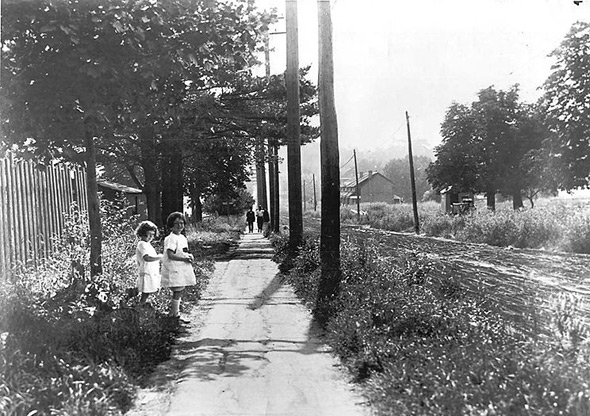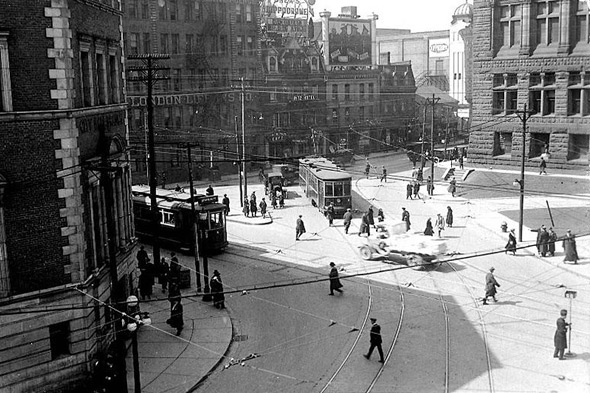 |
| Rochdale College back in the day |
Toronto, I'm sure you'll be shocked to learn, has historically been a pretty conservative place. It stretches back to our earliest days as a fiercely Protestant, fiercely British colony. In the 1830s, Anna Jameson, a writer and wife of the Attorney-General, was already complaining about the city's "cold, narrow minds", "confined ideas" and "by-gone prejudices". And when Hemingway lived here in the '20s, the city's Protestant reserve annoyed him enough that he told Ezra Pound that Canada was a "fistulated asshole". Even Marshall McLuhan came to the University of Toronto in part because he thought the city was small-minded and resistant to new ideas—and that would give him an intellectual challenge.
But by the late '60s and early '70s that had started to change. McLuhan had his own centre at U of T. Jane Jacobs had arrived and helped to kill
the Spadina Expressway. Urban advocates like David Crombie and John Sewell were being elected to city council—soon they'd be winning mayor's races, too. And a few block west of hippie-filled Yorkville there was Rochdale College.
Today, you might know it as the ugly concrete apartment building beside the Bata Shoe Museum (on the south side of Bloor just east of Spadina), but Rochdale started out life in 1968 as a radical experiment in post-secondary education. There would be no tuition, no traditional classrooms or professors. Students would plan and organize their own courses; if someone was interested in learning about something, they'd find some other students who shared their interest and maybe recruit "resource persons" to lend their expertise. They would work together to form the college's policy and administration, with each student sharing an equal vote. Even the building itself was designed with those collective principals in mind, centered around communal living spaces they called "ashrams". And out front went the
"Unknown Student" statue, erected, it would seem, as a monument to all those made to suffer at the hands of a traditional education.
Over the next seven years, Rochdale became a crucible for Toronto's quickly growing arts scene. Coach House Books, House of Anansi Press and Theatre Passe Muraille were all either founded at Rochdale or strongly involved in the college during their early years. And between them, they would g on to help support a generation of Toronto's writers—Margaret Atwood, Michael Ondaatje, Timothy Findley, bp nicol, Ann-Marie MacDonald, Gwendolyn MacEwen—and are still at it today, publishing the Christian Böks, Sheila Hetis, Michael Winters and Zoe Whittalls of the world.
This Magazine was at Rochdale, too. And so was Dennis Lee, who would go on to become Toronto's first poet laureate, write
Alligator Pie and co-write
Labyrinth and the songs for
Fraggle Rock. Science-fiction author Judith Merril was there. And so was Reg Hartt, showing films at Rochdale years before he started the Cineforum out of his house on Bathurst. And as if that weren't enough, the Hassle Free Clinic started there, too.
Of course, Rochdale also had its problems. A construction strike had delayed the college's opening, forcing them to take in non-Rochdale students who weren't interested in an experimental education. Meanwhile in Yorkville, the government was actively working to—in the words of hockey-hero-turned-Conservative-politician Syl Apps—"eradicate" the hippie culture from the neighbourhood. Lots of the people driven out by new, upscale development and baton-wielding cops just moved the few blocks to Rochdale. The building, originally designed to house 840 students became home to thousands—even more people who didn't care about the college's goals.
How big a problem that was depends on who you ask. Most people tell the Rochdale story in the format of the cautionary hippie tale: idealism + drugs + time = tragedy. The college's open door policy made it easy for biker gangs and hard drugs to move in. The halls teemed with tripping young people. There were overdoses and a few people jumped or fell or were pushed from windows. Lots of people were appalled. Ontario's Minister of Housing wasn't even sure they'd be able to sell the building if they wanted to. "I think you'd have to send in the men in white coats and butterfly nets and clean the joint out before anybody could make an offer on it," he said. The press started calling Rochdale "the vertical Haight-Ashbury" and "North America's largest drug distribution warehouse".
Not surprisingly, some former Rochdale residents tend to tell the story a little differently. They suggest that having a few overdoses and suicides over the years wasn't exactly rare for a downtown apartment building. And that the college was a beacon for distressed youth—many more of whom might have killed themselves if they hadn't found a welcoming home. The speed and harder drugs were a problem; softer drug use at Rochdale had always been open, abundant and, for the most part, peaceful. Even the federal government's own Le Dain Commission, looking into recreational drug-use, had studied the college as part of its process and eventually recommended the legalization of marijuana.
Still, by 1975 the authorities decided it was time to end the experiment. Police stormed the building, literally carrying the last few stubborn students out of the college and welding the doors shut behind them. The government renamed the building after a senator, turned it into an old folks home and, just in case the elderly had any revolutionary plans of their own, promised to "carefully screen tenants to keep any possible problems out."
-----
Heck, I suppose you can even add the Toronto Dreams Project to the list of artistic endeavors that owe some kind of vague, indirect debt to Rochdale, since at least a couple of my more inspiring professors were Coach House authors. There are great photos of life at Rochdale here and here and here and here and here and there's a copy of the 1969 curriculum here. (Some of which are from the college's online museum.) On YouTube, you can watch most of Ron Mann's Dream Tower documentary about the college, but the first part has no sound, so I'm just going to link straight to the second part.
BlogTO has also written a couple of articles about the college, which are especially worth checking out because of the comment sections; they've spontaneously become a place for former Rochdale students to reconnect and reminisce. My favourite excerpt comes courtesy of Reg Hartt himself:
In Hollywood a police officer who stopped me, when finding out I was from Toronto, asked what I had done there.
"I showed films at Rochdale College," I told him.
"Do you mean Canada's Communist Training Center," he asked.
Right there I knew that if the Hollywood police knew about Rochdale it had to be the hippest place on earth.
| This post is related to dream
11 Feeding The Annex
Dennis Lee, 1974 |





















